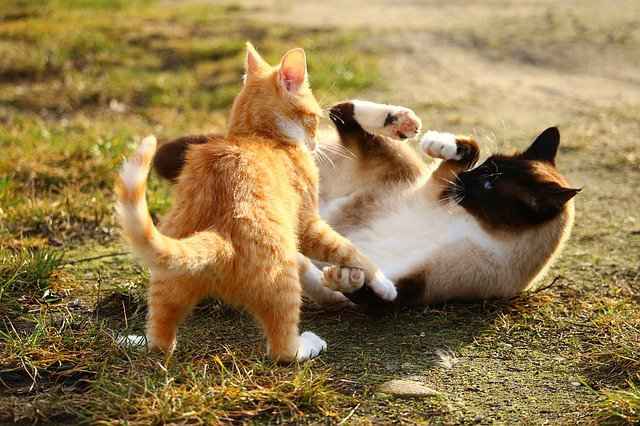Why Do Cats Lick Each Other [11 Reasons]
![Why Do Cats Lick Each Other [11 Reasons] Why Do Cats Lick Each Other](https://petcreeks.com/wp-content/uploads/2022/11/Why-Do-Cats-Lick-Each-Other.jpg)
Cats are fascinating creatures, and one of their most intriguing behaviors is licking each other.
Have you ever wondered why cats do this?
It turns out that there are a few reasons why cats engage in this behavior, including grooming, social bonding, and even showing affection.
In this blog post, we will explore the reasons why cats lick each other and what it means for their relationships.
So, if you’re a cat lover and want to know more about your feline friend’s behavior, keep reading!
Why Do Cats Lick Each Other
Cats lick and groom each other for various reasons. One of the most common reasons is to communicate their relationship with other cats.
This behavior is called allogrooming, and it is a way for cats to show affection and trust toward each other.
Cats that are bonded tend to groom each other as a display of affection.
Additionally, cats may lick each other for survival instinct, such as to remove fleas or other parasites.
Let’s dive in deeper…
11 Reasons Why Cats Lick Each Other
The following are some common reasons why cats lick each other:
Licking is a typical action among cats and is frequently used to communicate and associate with one another.
When cats lick each other, endorphins are released, which are substances that provide sensations of pleasure and relaxation.
This strengthens the social tie between the cats and contributes to the group’s sense of trust and fraternity.
Licking behavior can be noticed in cats of any age, gender, or relationship status, but it is especially essential in cats who live together or interact frequently.
2. Mutual grooming
Mutual grooming is a typical activity observed between cats.
This occurs when one cat licks another to remove dirt, debris, and parasites from their fur.
Cats may also use their tongues to assist one another in reaching difficult-to-reach regions such as the ears or the rear of the skull.
Mutual grooming is a crucial behavior for cats who live together or interact frequently because it keeps their physical health and cleanliness in check.
3. For Affection
Closely linked cats may use licking to express affection for one another.
When cats lick each other in this manner, they may do it gently and affectionately.
To express their love and affection, they may purr or rub against one other.
Affectionate licking is especially common amongst cats who were raised together or who have developed a deep attachment over time.
4. Submission
When one cat licks another, it can be interpreted as a show of submission.
As a sign of respect, the subordinate cat may offer its neck or face to be licked by the dominant cat.
This is especially typical in multi-cat families when a definite hierarchy has been formed.
As a way of demonstrating that it recognizes the dominant cat’s status in the group, the submissive cat may offer to be licked by the dominant cat.
5. Territorial marking
Cats have scent glands in their mouths, and they can transfer their fragrance when they lick each other.
This can be used to mark territory and alert other cats that they are part of the same pack.
This is especially common among cats who live in the same house and share the same space.
Cats can build a sense of familiarity and safety among their group by licking one another.
6. Allogrooming
Grooming behavior amongst two or more cats is referred to as allogrooming.
This behavior can assist cats in developing trust and strengthening their social relationships.
It can also aid in the formation of a sense of hierarchy inside the group.
A dominant cat, for example, may initiate grooming activity with a subordinate cat to assert its authority.
Allogrooming is a vital behavior for cats who live together or contact frequently because it keeps their physical and social health in check.
7. For Comfort
Cats may lick each other as a form of comfort.
A mother cat, for example, may lick her kittens to relax them or help them to sleep.
Similarly, closely attached cats may lick each other to provide emotional support and comfort.
Licking behavior in cats can induce emotions of relaxation and pleasure, as well as provide comfort during times of stress or anxiety.
8. Pheromone exchange
Cats have pheromone receptors in their mouths, and they can share pheromones when they lick each other.
This can assist children in communicating with one another and strengthening their social relationships.
Pheromones are chemical signals used by cats to communicate with one another.
Cats can build a sense of familiarity and trust within the group by exchanging pheromones.
This is particularly crucial in multi-cat households where cats must share resources and space.
9. Dominance
In some circumstances, licking behavior might be interpreted as a show of dominance.
A dominant cat may lick a subordinate cat to assert its dominance or to remind the inferior cat of its position in the hierarchy.
Dominant behavior can be found in multi-cat households with a clearly defined pecking order.
To retain its status at the top of the hierarchy, a dominant cat may engage in licking behavior.
10. Healing effects
Cats can benefit from licking as well. When one cat is hurt, the other cat may lick the wound to aid in healing.
This is because cat saliva includes antibacterial characteristics that can aid in wound cleaning and healing.
11. Health issues
Finally,
A cat with an injury, for example, may be licked by another cat to clean the wound and promote recovery.
Cats may similarly lick one other’s eyes to remove discharge or debris.
Licking activity can be observed in cats that live together or interact frequently, and it can be an important element in preserving a cat’s physical health.
Learn more about why your cat licks you.
Questions And Answers
Why do cats lick each other?
Cats lick each other for various reasons – to bond, show affection, groom their fur, and establish dominance.
Is it normal for cats to lick each other?
Yes, it is entirely normal for cats to lick each other, especially if they are siblings or have a close relationship.
Does cat licking indicate aggression?
Not necessarily. While cats licking each other can be a sign of establishing dominance, it can also indicate affection and grooming behavior.
Can cats get sick from licking each other?
There is always a risk of transmitting diseases when cats lick each other.
However, as long as your cats are healthy, the risk of them getting sick is relatively low.
Can cats overdo it with grooming each other?
Yes, excessive licking and grooming can lead to hair loss and skin irritation.
If you notice this behavior, it is best to intervene and redirect their focus.
Can cats groom other animals besides cats?
Yes, cats may groom dogs or other animals they share a living space with. It is typically a sign of trust and bonding.
Learn more about why cats bite each other.
Conclusion
In conclusion, cats lick each other for a variety of reasons, including grooming, social bonding, and even as a sign of submission.
While it may seem strange to us humans, it’s a natural behavior for our feline friends.
So the next time you catch your cats licking each other, don’t be alarmed.
It’s just their way of showing affection and maintaining their social hierarchy.

![Will Beagles Return Home If Lost [Answered] Will Beagles Return Home](https://petcreeks.com/wp-content/uploads/2021/04/beagle-5964194_640.jpg)



![Are Bengal Cats Good Pets [Reasons To Get One] Are Bengal Cats Good Pets](https://petcreeks.com/wp-content/uploads/2023/05/Are-Bengal-Cats-Good-Pets-768x555.jpg)
